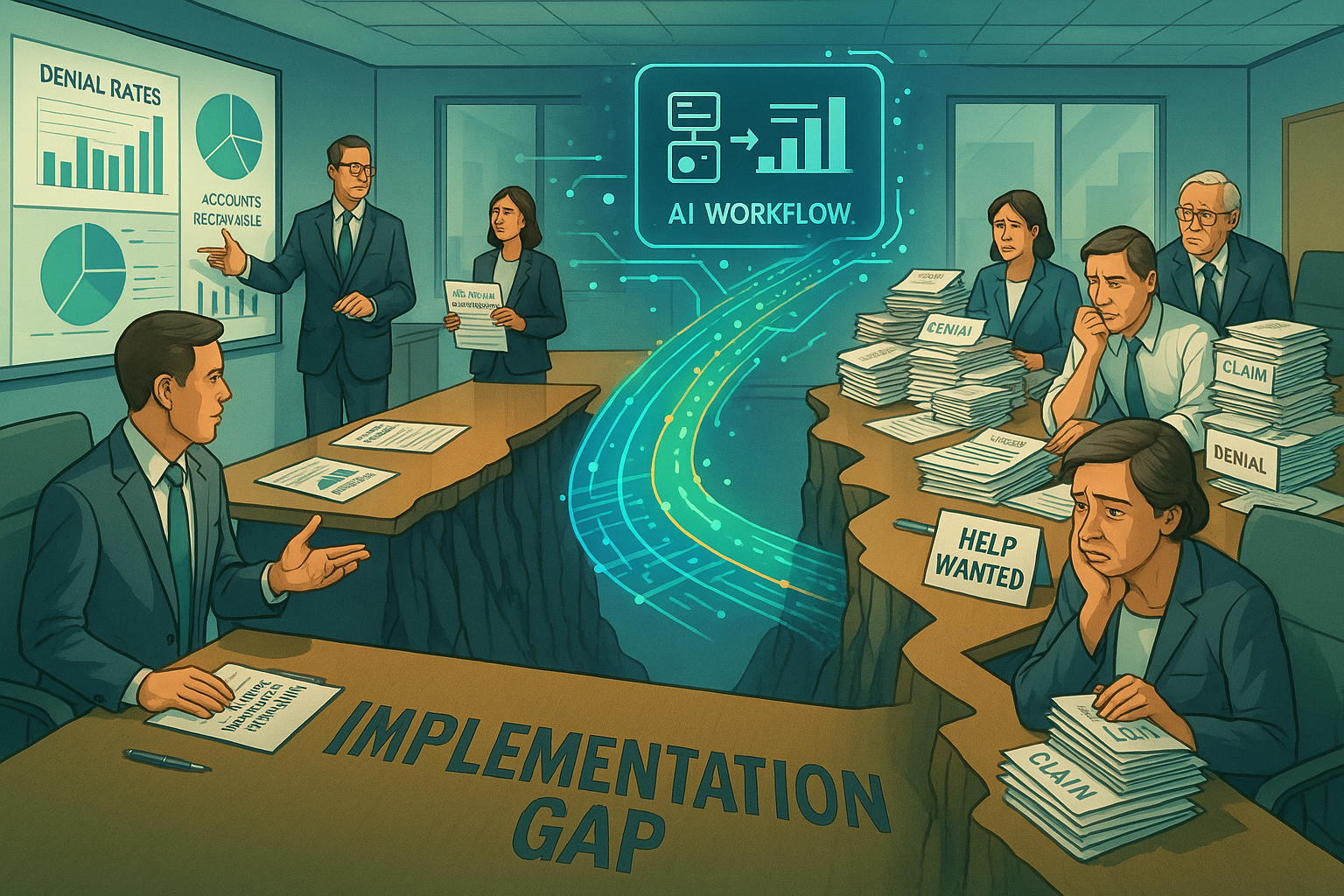The Watch-Borrowing Phenomenon
“Consultants borrow your watch to tell you the time.”
This phrase resonates deeply with healthcare administrators who’ve engaged revenue cycle consultants. The scenario is all too familiar: A healthcare organization, struggling with mounting denials, aging accounts receivable, or declining cash flow, brings in external consultants. After weeks of analysis, the consultants deliver a polished presentation confirming what leadership already suspected—there are problems with denial management, staff productivity, or payer-specific issues.
What follows is a familiar cycle of disappointment. The consultants leave behind recommendations that, while sound in theory, often fail to translate into meaningful operational improvements. The fundamental dilemma? Identifying problems is relatively easy; implementing effective solutions is extraordinarily difficult.
The Knowledge-Implementation Gap
Healthcare revenue cycle consulting currently suffers from a critical disconnect between diagnosis and treatment. Consider these realities:
- Data without direction: Most consulting engagements successfully identify problematic areas but rarely translate these insights into executable actions. Reports might show that certain payers have high denial rates for specific CPT codes, but they don’t create a systematic approach to address these denials.
- Recommendations without resources: Healthcare organizations frequently operate with understaffed revenue cycle departments. When consultants recommend “increased follow-up” or “enhanced pre-claim review,” these recommendations collide with the harsh reality of resource constraints.
- Insights without infrastructure: Even when consultants identify specific workflow improvements, healthcare organizations often lack the technical infrastructure or operational bandwidth to implement these changes effectively.
The result is a frustrating cycle where consulting engagements repeatedly identify similar issues, but healthcare organizations struggle to implement lasting solutions.
Why Traditional Consulting Falls Short
Traditional revenue cycle consulting approaches are fundamentally limited by several factors:
Limited Data Analysis Capabilities
Most consultants rely on basic tools like Excel and standard reports from the client’s EHR or billing system. While these tools can identify broad trends, they fall short in several critical ways:
- They can’t effectively merge disparate data sources to create comprehensive analyses
- They lack the processing power to analyze millions of transactions for subtle patterns
- They can’t predict which claims are likely to be problematic before submission
Lack of Implementation Tools
Even when consultants correctly diagnose problems, they typically lack the tools to help implement solutions:
- They don’t have the technology to automate repetitive tasks
- They can’t offer additional staff resources to execute recommendations
- They can’t integrate directly with client systems to drive workflow improvements
Absence of Accountability Structures
Traditional consulting models create inherent disconnects in accountability:
- Consultants are typically compensated for delivering recommendations, not results
- Implementation is left to client teams who may lack capacity or expertise
- There’s rarely a systematic approach to measure the impact of recommended changes
Bridging the Gap: The Solution-Oriented Approach
Forward-thinking healthcare organizations are now demanding more than just analysis from their consulting partners. The new paradigm in revenue cycle consulting must bridge the gap between knowing and doing through:
Integrated Technology Solutions
Modern consulting approaches should leverage technology that goes beyond analysis to enable action:
- AI-powered systems that not only identify problems but predict them before they occur
- Workflow automation tools that reduce manual intervention for routine tasks
- Integrated platforms that connect insights directly to operational processes
Human Resource Augmentation
The most effective consulting partnerships now include staff augmentation components:
- Specialized resources to execute on specific recommendations
- Virtual teams that can be deployed flexibly to address priority issues
- Knowledge transfer protocols to build sustainable internal capabilities
Accountability-Based Engagement Models
New consulting models are shifting toward shared accountability for results:
- Compensation structures tied to specific, measurable improvements
- Phased implementation plans with clear milestones and metrics
- Ongoing monitoring and adjustment rather than point-in-time assessments
The Path Forward: From Diagnosis to Transformation
Healthcare revenue cycle leaders must demand more from their consulting partners. The days of paying for elaborate presentations that merely confirm existing suspicions should be over. Instead, organizations should seek partners who offer:
- Advanced analytical capabilities that leverage AI and machine learning to provide deeper insights and predictive guidance
- Implementation toolkits that include technology, resources, and methodologies to execute recommended changes
- Shared accountability models that align consultant compensation with measurable improvements in key performance indicators
Conclusion: A New Era in Revenue Cycle Consulting
The healthcare industry can no longer afford the luxury of consulting engagements that diagnose without treating. As financial pressures mount and staffing challenges persist, revenue cycle leaders need partners who can help them not just understand problems but solve them.
The most valuable consultants in today’s environment aren’t those who can create the most impressive analysis or the most beautiful dashboard—they’re the ones who can demonstrably move the needle on collections, reduce denials, and improve the financial health of the organizations they serve.
In the end, healthcare providers don’t need someone to borrow their watch and tell them the time. They need partners who can help them build a better timepiece altogether.
Lockbox AI partners with healthcare consulting firms to enhance their services with AI-powered analytics, automation, and staff augmentation, enabling consultants to not just identify problems but implement effective solutions. Learn more about how we can transform your consulting practice or healthcare revenue cycle operations.





